The SAPPHIRE Vapor-X HD 7770 GHz Edition OC Video Card is SAPPHIRES latest offering in the AMD Radeon HD 7770 line-up of graphics cards. The Vaper-X HD 7770 GHz Edition OC uses a vapor design air cooler with two fans to provide a quiet and cool gaming environment over the standard AMD reference design.
Introduction
A few days ago we have reviewed XFX’s Radeon HD 7750 Black Edition factory overclocked video card. The XFX R7750 Black Edition cost roughly about $124.99, and had a very nice solid composition with a Double Dissipation (Dual-Fan) cooler design. This time around we are taking a look at SAPPHIRE’s VAPOR-X HD 7770 GHz EDITION OC video card, which comes with a very similar cooler design, and cooling performance. The SAPPHIRE VAPOR-X HD 7770 GHz EDITION OC follows AMD’s Radeon HD 7770 reference design with the exception of a custom SAPPHIRE Vapor Chamber design cooler, along with a higher factory overclocked GPU and Memory frequency.

As we take a look at the SAPPHIRE VAPOR-X HD 7770 GHz EDITION OC, we do have to keep in mind that we are still testing a fairly low-end mid-range graphics card. Therefore, these cards are not designed to dominate the gaming world at really high resolutions of 2560 x 1080 or 1920 x 1080, unless some of the graphics settings are tuned down. So our main focus in this review will be to see how well the card is built, how far we can push the card without losing stability, and how it actually performs in real-world modern games at resolutions of 1280 x 1024, 1680 x 1050, and 1920 x 1080. The SAPPHIRE VAPOR-X HD 7770 GHz EDITION OC costs roughly $134.99 with a product promotion. Otherwise you should expect spending about $149.99 on this card.
Features & Specifications
Vapor-X Technology SAPPHIRE’s innovative Vapor-X cooling technology allows products to run not only cooler but also much quieter. A Vapor-X product means a virtually silent gaming experience and more headroom to explore performance tweaking ! |
|
| Black Diamond Choke & Full Solid Cap DesignChoke is an important component of the graphics card. By working with the component engineer, Sapphire’s patent pending choke is 10% cooler and offers 25% more power efficiency than a normal choke. The graphics card will be more reliable and save energy. Improved reliability and better overclocking are possible by using only high-polymer, aluminum capacitors which posses far superior characteristics than regular aluminum capacitor for a longer product life. When operational temperatures drop by 20°C, the product life span is extended by a factor of ten, when the operational temperature increases by 20°C, the product life span only decreases by 10%. |
| Specifications | AMD Radeon HD 7750 | AMD Radeon HD 7770 |
SAPPHIRE VAPOR-X HD 7770 GHz EDITION OC |
| Chipset Version |
ATI Radeon HD 7750 | ATI Radeon HD 7770 | ATI Radeon HD 7770 |
| Process | 28nm | 28nm | 28nm |
| Stream Processors | 512 | 640 | 640 |
| Texture Units | 32 | 40 | 40 |
| ROPs | 16 | 16 | 16 |
| GPU Clock | 800 MHz | 1000 MHz | 1100 MHz |
| Memory Bus | 128 bit | 128 bit | 128 bit |
|
Memory Clock
|
1125 MHz | 1125 MHz | 1300 MHz |
| Memory Size | 1 GB | 1 GB | 1 GB |
| Memory Type | GDDR5 | GDDR5 | GDDR5 |
| Minimum Power Supply Requirement | 450 Watt | 450 Watt | 450 Watt |
Product Overview
Click Images to Enlarge
The packaging for the SAPPHIRE VAPOR-X HD 7770 GHz EDITION OC video card is quite nice. The choice of dark and light blue colors makes the box look very sleek and professional. There is not much to the box besides showing off some of the features of the card. These features include a 1GB GDDR5 memory, the card being a factory overclocked card, the Vapor-X vapor chamber design cooler, and of course the fact that this package also comes included with a 1.8 meter HDMI cable.
Click Images to Enlarge
Inside the cover, we can see a cardboard box, with a sturdy cardboard divider to hold the video card and all the accessories. There was no Driver CD or Installation Guide included, which is not a big deal breaker for an advanced computer user, but could be an issue for the rookie gamers that are not very familiar with the hardware installation process. Do note that the complete boxing for the video card is fully 100% recyclable cardboard paper, so its easy to recycle and keep our environment clean.
Inside the box we can find the video card in a anti-static bubble bag, with the following accessories: 1.8 meter HDMI monitor cable, a VGA to DVI adapter, and a Molex to a single 6-pin PCI-E Power Connector. There are no other necessary parts required, but a Crossfire Bridge would have been a nice addition for the users that are going with a SAPPHIRE VAPOR-X HD 7770 GHz EDITION OC CrossfireX configuration.
Click Images to Enlarge
And here we have it, the actual video card. As we can see, the video card is covered by a plastic transparent cover to protect the video card’s shroud from any scratches during installation and during shipment. Technically that cover can stay on, and we know some people that intentionally keep the cover on to protect their cards, but we would not recommend this as it obstructs proper airflow. On the right side we can see the cover taken off the video card.
Click Images to Enlarge
The SAPPHIRE HD 7770 Vapor-X cooler design is extremely similar to the XFX Radeon HD 77xx, 78xx, and 79xx non-reference design video cards. The main difference is the design of the shroud, the fans used, and the actual heatsink design on the card. The XFX Radeon HD 7750 Black Edition video card we recently reviewed uses special fans that block out dust build-up inside the motor. The SAPPHIRE VAPOR-X HD 7770 GHz EDITION OC video card does not seem to have this feature as we couldn’t find any information about it. On the bright side, the SAPPHIRE VAPOR-X HD 7770 GHz EDITION OC does use a vapor chamber design cooler, which is basically a block or “chamber” right at the GPU. The liquid inside the chamber evaporates and fuels through the heatpipe design of the cooler to channel the heat to the heatsink fins. Then the heat gets cooled off by the cool air blown at the heatsink fins by the two fans on the heatsink. This is a far better design than other simple cooling solutions.
Click Images to Enlarge
Generally, a dual fan design cooler is capable of providing almost up to 3x the cooling performance of a single fan reference design cooler, while also maintaining a much lower acoustic noise, as the fans do not have to rotate at higher RPM. On the bottom of the cooler cover we can see the model name of the card, the SAPPHIRE HD 7770, while the top of the cover shows the SAPPHIRE logo. The fans have a nice Vapor-X logo on them to show that this card is the Vapor-X Overclocked Edition video card. The rear of the card has 4 monitor connectors, including one Single-Link DVI port, one Dual-Link DVI port, one HDMI port, and one standard DisplayPort. Above the DisplayPort and the HDMI port, we can see exhaust holes. However, with such cooler design, some of the heat will be exhausted inside the chassis as well, which is why it is important to have good air circulation inside your system.
Click Images to Enlarge
Finally, on the front of the card we can see a single 6-Pin PCI-E power connector. The card is designed at around 70W TDP, which is why only a single 6-Pin PCI-E power connector is necessary. The other side of the card, more towards the back includes a crossfire connection, however no crossfire bridges are included with this video card.
Testing Methodology
The OS we use is Windows 7 Pro 64bit with all patches and updates applied. We also use the latest drivers available for the motherboard and any devices attached to the computer. We do not disable background tasks or tweak the OS or system in any way. We turn off drive indexing and daily defragging. We also turn off Prefetch and Superfetch. This is not an attempt to produce bigger benchmark numbers. Drive indexing and defragging can interfere with testing and produce confusing numbers. If a test were to be run while a drive was being indexed or defragged, and then the same test was later run when these processes were off, the two results would be contradictory and erroneous. As we cannot control when defragging and indexing occur precisely enough to guarantee that they won’t interfere with testing, we opt to disable the features entirely.
Prefetch tries to predict what users will load the next time they boot the machine by caching the relevant files and storing them for later use. We want to learn how the program runs without any of the files being cached, and we disable it so that each test run we do not have to clear pre-fetch to get accurate numbers. Lastly we disable Superfetch. Superfetch loads often-used programs into the memory. It is one of the reasons that Windows Vista occupies so much memory. Vista fills the memory in an attempt to predict what users will load. Having one test run with files cached, and another test run with the files un-cached would result in inaccurate numbers. Again, since we can’t control its timings so precisely, it we turn it off. Because these four features can potentially interfere with benchmarking, and and are out of our control, we disable them. We do not disable anything else.
We ran each test a total of 3 times, and reported the average score from all three scores. Benchmark screenshots are of the median result. Anomalous results were discounted and the benchmarks were rerun.
Please note that due to new driver releases with performance improvements, we rebenched every card shown in the results section. The results here will be different than previous reviews due to the performance increases in drivers.
Test Rig
| Test Rig | |
| Case | Cooler Master Storm Trooper |
| CPUs | Intel Core i7 3960X (Sandy Bridge-E) @ 4.6GHz |
| Motherboards | ASUS P9X79 WS X79 Chipset Motherboard |
| Ram | Kingston HyperX Genesis 32GB (8x4GB) 1600Mhz 9-9-11-27 Quad-Channel Kit |
| CPU Cooler | Noctua NH-D14 Air Cooler |
| Hard Drives | 2x Western Digital RE3 1TB 7200RPM 3Gb/s Hard Drives in RAID 0 |
| SSD | 2x Kingston HyperX 240GB SATA III 6Gb/s SSD in RAID 0 (Main) 1x Kingston HyperX 240GB SATA III 6Gb/s SSD (Storage) |
| Optical | ASUS DVD-Burner |
| GPU | NVIDIA GeForce GTX 690 2x2GB (4GB) Video Card NVIDIA GeForce GTX 680 2GB Video Card NVIDIA GeForce GTX 670 Video Card NVIDIA GeForce GTX 580 1.5GB Video Card Palit GTX 560 Ti Sonic 1GB Video Card EVGA SuperClocked GTX 560 1GB Video Card AMD HD7970 3GB Video CardAMD HD7950 3GB Video Card AMD HD7870 2GB Video Card SAPPHIRE VAPOR-X HD 7770 GHz EDITION OC (1200 MHz/ 1475 MHz) SAPPHIRE VAPOR-X HD 7770 GHz EDITION OC (1100 MHz/ 1300 MHz) AMD HD7770 1GB Video Card XFX HD7750 Black Edition 1GB Video Card (Factory Overclock) AMD HD7750 1GB Video Card AMD HD6990 4GB Video Card AMD HD6970 2GB Video Card |
| PSU | Cooler Master Silent Pro Gold 1200W PSU |
| Mouse | Razer Imperator Battlefield 3 Edition |
| Keyboard | Razer Blackwidow Ultimate Battlefield 3 Edition |
Synthetic Benchmarks & Games
| Benchmarks |
|---|
| 3DMark Vantage |
| 3DMark 11 |
| Crysis 2 |
| Just Cause 2 |
| Lost Planet 2 |
| Metro 2033 |
| Battlefield 3 |
| Unigine Heaven 3.0 |
| Batman Arkham City |
| Dirt 3 |
| H.A.W.X. 2 |
Synthetic Benchmarks
3DMark 11
Now let’s check out how well the SAPPHIRE VAPOR-X HD 7770 GHz EDITION OC actually performs in synthetic benchmarks. 3DMark 11 is our first synthetic benchmark. This benchmark takes full advantage of DirectX 11 features, as well as tessellation that both AMD and NVIDIA graphics cards support. Getting around 6000+ score indicates fairly good performance for modern 3D applications. Checking out the scores shows us that the Reference AMD HD 7770 video card almost reached the 6000 points in the Entry level benchmark. The SAPPHIRE VAPOR-X HD 7770 GHz EDITION OC at factory overclocked settings gets us 6501 points and a manually overclocked card can get us up to 7152 points. This just shows how much this card is actually capable of when it is manually overclocked. Unfortunately, going to larger resolutions and higher graphics settings completely destroys the SAPPHIRE VAPOR-X HD 7770 GHz EDITION OC, but then again, even high-end cards get ripped to shreds with 3DMark 11.
3DMark Vantage
3DMark Vantage gives us a better overview of actual average video game performance. As we can see with 3DMark Vantage we were able to reach 7283 points at factory settings and 8017 points overclocked in the Extreme (1920 x 1080) preset. Compared to a reference AMD HD 7750, we are almost getting double the performance, which is quite impressive. However comparing it to the EVGA SuperClocked GTX 560, we are still about 1000 points behind even with the maximum overclock we were able to achieve with the SAPPHIRE VAPOR-X HD 7770 GHz EDITION OC video card. Interestingly, in our Entry level testing, the SAPPHIRE VAPOR-X HD 7770 GHz EDITION OC performed faster than the EVGA SuperClocked GTX 560.
Unigine Heaven 3.0
Unigine Heaven is a benchmark program based on Unigine Corp’s latest engine, Unigine. The engine features DirectX 11, Hardware tessellation, DirectCompute, and Shader Model 5.0. All of these new technologies combined with the ability to run each card through the same exact test means this benchmark should be in our arsenal for a long time.
Here is our final synthetic benchmark we are going to run. Our top test for Unigine Heaven 3.0 was tested with extreme tessellation enabled, with 4X Anti-Aliasing, while the bottom test was ran without any tessellation with no AA. As we can see tessellation and Anti-Aliasing has a big impact on performance in 3D Applications. However, most games today look just fine without any tessellation, and some allow low tessellation settings to add slightly more visual effects to the game, but no big difference in performance.
Game Benchmarks
Battlefield 3
Battlefield 3, was one of the most anticipated multiplayer first person shooters to hit the market. It became one of our main games for benchmarking, that can really push the limits of today’s hardware and visual quality boundaries. We tested both Ultra settings at higher resolutions and Medium settings at mid to lower resolutions. From the performance we got, we can see that Ultra settings really push the limits of the card and the SAPPHIRE VAPOR-X HD 7770 GHz EDITION OC video card just can’t keep up with the workload being thrown at it. Taking the graphics down to medium settings on the other hand show a big difference in performance, which tells us that the game will most likely be able to play smoothly at High Settings with the SAPPHIRE VAPOR-X HD 7770 GHz EDITION OC Video Card even at 1680 x 1050 resolution. If you’re looking at playing the game at 1920 x 1080, you should keep the settings at Medium – High settings.
Metro 2033
While Metro 2033 was released 2 years ago, it still is one of the most demanding games currently on the market. We tested both DX11 and DX10 settings to find the idea sweet spot that the SAPPHIRE VAPOR-X HD 7770 GHz EDITION OC can handle. Looks like for optimal gaming experience at higher resolutions, DX10 should be used with no AA and 4x AF at 1680 x 1050 resolution. Anything above 45FPS should be smooth enough for enjoyable gameplay. If we take a look at the higher graphics settings, we would need a card like the GTX 580, 670 or 680, or from AMD’s side the HD 7950 or 7970 to really enjoy the extra eye candy the higher resolution and graphics settings will offer. Those cards do run quite expensive from about $350 to $600, depending on model and which company manufactures it.
Batman Arkham City
Batman Arkham City has great graphics and thankfully the SAPPHIRE VAPOR-X HD 7770 GHz EDITION OC can easily handle the game even at maximum settings at 1920 x 1080 without PhysX being enabled. It is however good that the SAPPHIRE VAPOR-X HD 7770 GHz EDITION OC has slightly higher performance over the reference AMD Radeon HD 7770 video card, because with PhysX enabled, every little bit of performance gain will be beneficial to a smooth gameplay. There is no point in taking the graphics to lower levels, and the SAPPHIRE VAPOR-X HD 7770 GHz EDITION OC will have no problem handling the game even at the most intense action scenes in the game.
Crysis 2
Most of us probably heard that Crytek released a DX11 patch with a High-Resolution Texture pack for Crysis 2. While the patch was much appreciated, the slight graphics differences the patch offered were not worth it compared to the major performance hit it had on even powerful gaming systems. Because of this, there is no real reason to even bother downloading and enabling the graphics enhancements for an average gamer. With DirectX 10 and High Graphics settings on the other hand, even at 1680 x 1050, the user should be getting an average frame rate of 44.9 FPS, which is roughly about 4 FPS higher than the reference AMD Radeon HD 7770, and about 11 FPS higher than the AMD Radeon HD 7750. With even more overclocking, the frame rates can be raised all the way up to 50 FPS at 1680 x 1050.
Just Cause 2
When we check out the performance in Just Cause 2, we can clearly see that at Maximum graphics settings without GPU Water Simulation (Not Available on AMD cards, because it requires CUDA support that only Nvidia cards offer) reach up to 70 FPS at 1680 x 1050 and 64 FPS at 1920 x 1080. These frame rates are fantastic, and the game should play very smoothly. With an AMD Radeon HD 7750, while the game would be fairly smooth most of the time, there are chances of entering graphics intensive scenes where the 7750 might show some slower performance.
Lost Planet 2
Lost Planet 2 is a DX 10 and 11 based game. We ran the DX 11 benchmark to test for the overall gaming performance. Unfortunately, the SAPPHIRE VAPOR-X HD 7770 GHz EDITION OC will not be able to play the game at High Graphics settings, but lowering the tessellation option slightly would add tremendous performance increase to the game. To enjoy the game at high graphics and tessellation settings, we would recommend at least a GeForce GTX 560 Ti or an AMD Radeon HD 7870.
Dirt 3
Dirt 3 is a fun racing game that most gamers that like playing racing games would enjoy playing. While the XFX Radeon HD 7750 Black Edition Factory Overclocked video card struggled to get playable frame rates at Max settings, the SAPPHIRE VAPOR-X HD 7770 GHz EDITION OC, has no problem reaching roughly 17 FPS higher scores at 1920 x 1080 resolution. This translates to much better performance and less sluggish gameplay.
H.A.W.X 2
H.A.W.X. 2 is one of the few games you will be able to fully take advantage of DX 11 Tessellation, while maintaining a high frame rate of 71 FPS. Even slower video cards would be able to fully play H.A.W.X 2 at maximum graphics settings, but then again, to also make sure your other games will play smoothly, it’s worth spending extra $20 on a factory overclocked HD 7770, over a factory overlocked HD 7750.
Stability Tests
TEMPERATURES
To measure the temperature of the video card, we used EVGA’s Precision X and ran the Metro 2033 benchmark in a loop to find the Load temperatures for the video cards. The highest temperature was recorded. After looping for 10 minutes, Metro 2033 was turned off and we let the computer sit at the desktop for another 10 minutes before we measured the idle temperatures.
Many users are concerned about their video card temperatures, and not many users actually have a well ventilated case. This is why its best to have a video card that has a proper cooler that can keep the card as cool as possible. We can see that SAPPHIRE really did their research before releasing their factory overclocked Vapor-X video card. The card idles at about 5 degrees lower temperature than the XFX HD 7750 Black Edition which also uses a dual-fan air cooler. On the other hand the SAPPHIRE VAPOR-X HD 7770 GHz EDITION OC does have slightly higher load temperatures of 61C at factory overclocked settings and 63C at manually overclocked settings. These temperatures are still far below the actual limit that these GPUs can take, which means that even poorly ventilated cases should not have a problem with the SAPPHIRE VAPOR-X HD 7770 GHz EDITION OC. Do keep in mind that the 7770 has 128 more stream processors and is running at much higher clock speeds to begin with than the AMD Radeon HD 7750. Temperatures should be much higher without a vapor chamber design cooler.
POWER CONSUMPTION
To get our power consumption numbers, we plugged in our Kill A Watt power measurement device and took the Idle reading at the desktop during our temperature readings. We left it at the desktop for about 15 minutes and took the idle reading. Then we ran Metro 2033 for a few minutes minutes and recorded the highest power usage.
The SAPPHIRE Vapor-X HD 7770 GHz EDITION OC video card has a fairly low power consumption compared to the other cards, however it also has far less performance as well. But considering that the XFX HD 7750 Black Edition used 166 Watts of idle power, the SAPPHIRE Vapor-X HD 7770 GHz EDITION OC actually uses 5W less at idle. At full load, the SAPPHIRE Vapor-X HD 7770 GHz EDITION OC only uses 4 Watts more than a reference AMD Radeon HD 7770, and 19 Watts more than the XFX Radeon HD 7750 Black Edition. These are very nice low power consumption results.
Overclocking
Overclocking the SAPPHIRE Vapor-X HD 7770 GHz EDITION OC was a piece of cake. We have used EVGA’s Precision X overclocking utility to push the SAPPHIRE card as far as we could, and we managed to hit up to 1250 MHz (Core) / 1525 MHz (Memory), but due to some stability issues at these high clocks in certain games like Lost Planet 2, we lowered our settings to 1200 MHz (Core) and 1475 MHz (Memory). These are the settings we have used for all of our manually overclocked benchmark results in the charts above. No fan settings or voltage settings needed to be adjusted. These settings were just easily set through the overclocking utility while we were running Unigine Heaven 3.0 in the background to check for stability.
Conclusion
The SAPPHIRE VAPOR-X HD 7770 GHz EDITION OC video card is definitely a fantastic video card for an average gamer. It does not necessarily have the potential to max out every single video game on the market at higher resolutions, but our tests showed that the video card exceeds the performance requirements at lower resolutions at medium graphics settings. This means that the SAPPHIRE VAPOR-X HD 7770 GHz EDITION OC should have enough power to run all the latest video games at medium to high graphics settings at higher resolutions of 1680 x 1080 and 1920 x 1080. This was not possible on a AMD Radeon HD 7750 graphics card.
What we really enjoyed about the SAPPHIRE VAPOR-X HD 7770 GHz EDITION OC was that it is able to overclock fairly nicely with its stock vapor chamber cooler, while maintaining very low acoustic levels and keeping the GPU very cool. This means that we are able to push the card even further than what SAPPHIRE initially overclocked it to for better performance. But our question of whether the card is worth the money still lies unanswered. We do believe the card is worth the money, however to really maximize the graphics quality of your games, you might want to invest an additional $30-$75 more on a more powerful video card like the EVGA SuperClocked GTX 560 or a basic GTX 560 Ti. If you will be gaming at lower resolutions anyways, this card should not disappoint you at all. Throw Skyrim or Diablo 3 at it, and it should still work without any issues at high graphics settings.
| OUR VERDICT: SAPPHIRE VAPOR-X HD 7770 GHz EDITION OC | ||||||||||||||||||
|
||||||||||||||||||
| Summary: The SAPPHIRE VAPOR-X HD 7770 GHz EDITION OC video card really shines when it comes to overclocking and getting even more performance out of your gaming. A price of $134.99 is very fair for the performance, quality, and cooling potential this card offers, however $30-$75 more could get you easily a GTX 560 or a GTX 560 Ti, which would really allow for some high-resolution gaming. The SAPPHIRE VAPOR-X HD 7770 GHz EDITION OC video card is a very decent mid-range graphics card, which is why we’re awarding it Bjorn3D’s Seal of Approval. |
 Bjorn3D.com Bjorn3d.com – Satisfying Your Daily Tech Cravings Since 1996
Bjorn3D.com Bjorn3d.com – Satisfying Your Daily Tech Cravings Since 1996














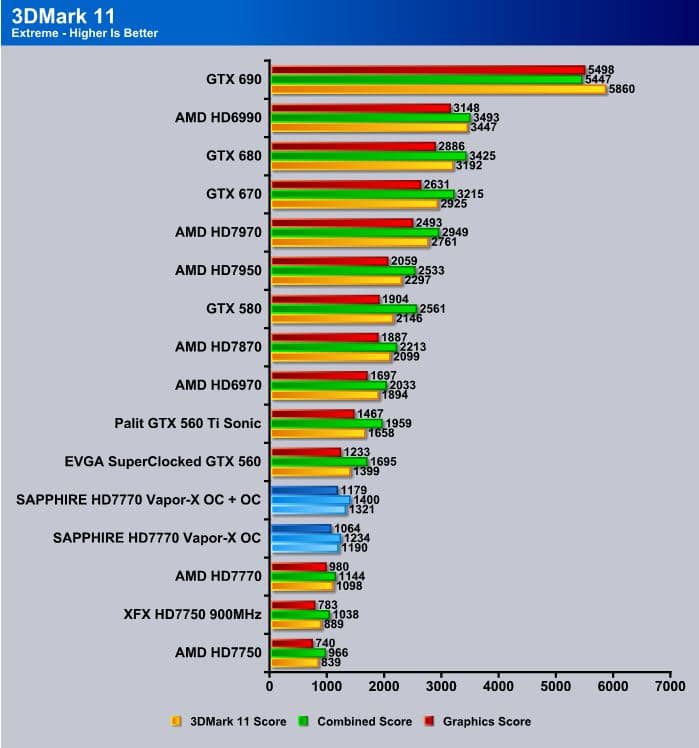



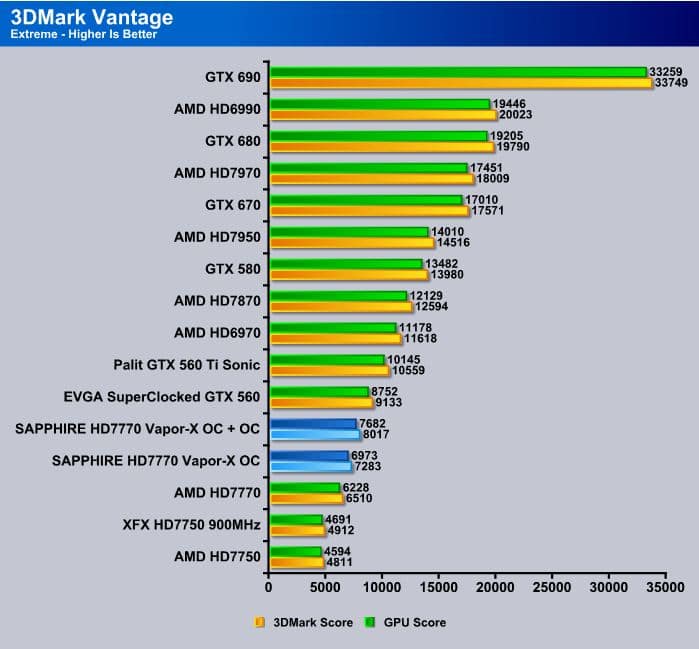







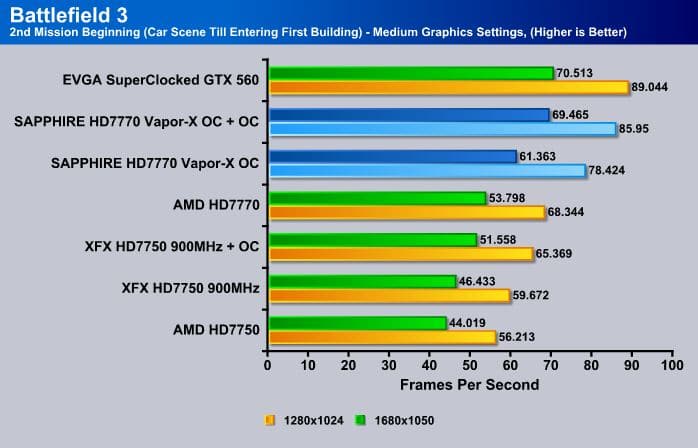










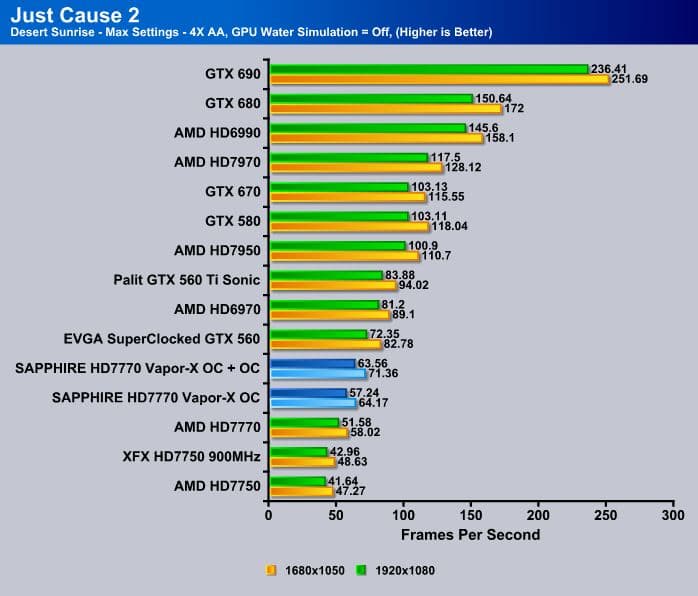





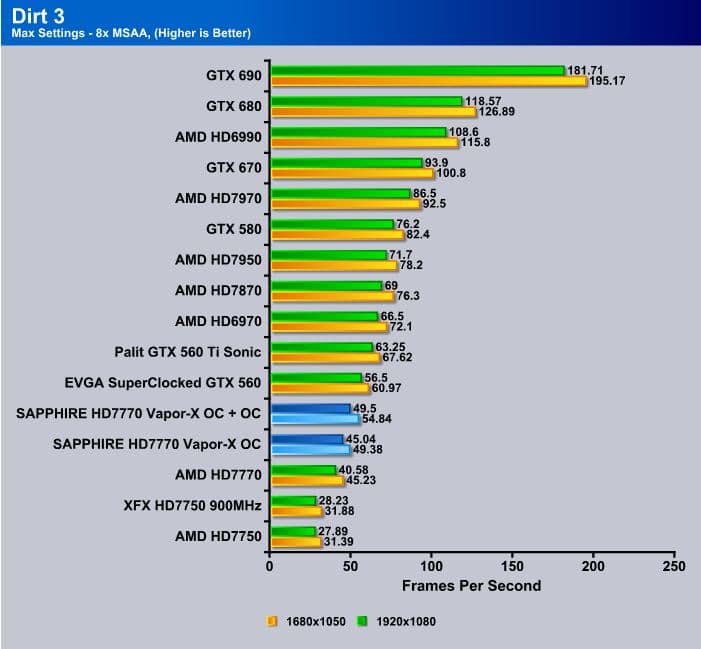










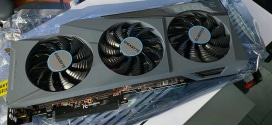


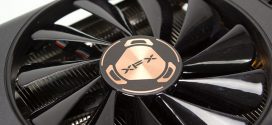




Is the power consumption test for all system? or for the card only?